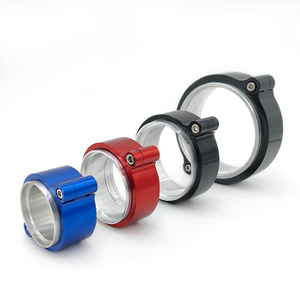In industrial manufacturing and piping systems, clamps are a common type of fastener widely used for connecting pipes, hoses, and other equipment. Based on their structure, clamps are mainly categorized into single-ear and double-ear clamps. Choosing the right type of clamp is a challenge that many users face in practical applications. This article provides a detailed introduction to the differences, characteristics, and application scenarios of single-ear and double-ear clamps to help users make the right decision.
1. Characteristics and Applications of Single-Ear Clamps
Single-ear clamps, due to their simple structure, are usually used in light-load applications. For example, they are commonly applied in the automotive industry for connecting oil pipes and cooling water hoses. The main features of single-ear clamps include:
Easy Installation: The single-ear design allows for quicker installation, making it suitable for areas with limited space.
Strong Clamping Force: Despite their simple structure, single-ear clamps provide sufficient clamping force to ensure a tight seal at the connection point.
Application Scenarios: Single-ear clamps are often used in situations where minimal adjustment is required and where disassembly is infrequent. They are suitable for medium-pressure fluid piping connections.
2. Characteristics and Applications of Double-Ear Clamps
Double-ear clamps, due to their dual-ear structure, provide stronger clamping force, making them particularly suitable for high-load applications that require high stability. Key features of double-ear clamps include:
Greater Stability: The dual-ear design offers more adjustment flexibility, making it suitable for pipes with slight diameter variations.
Wide Adaptability: Thanks to the double-ear structure, these clamps can better accommodate pipes or hoses of various shapes and sizes.
Application Scenarios: Double-ear clamps are widely used in situations that require strong clamping force, such as in industrial equipment, heavy machinery, and high-pressure piping systems.
3. Recommendations for Choosing Between Single-Ear and Double-Ear Clamps
In practical applications, how to choose between single-ear and double-ear clamps depends on the specific requirements. Here are some recommendations to help users make an informed decision:
Application Scenarios: For low-pressure pipe or hose connections where the frequency of assembly and disassembly is low, single-ear clamps are a great option. In high-pressure environments requiring greater stability, double-ear clamps are recommended.
Installation Space: Single-ear clamps are ideal for applications with limited space, while double-ear clamps, due to their more complex structure, require more installation space. Be sure to leave enough space for operation when installing double-ear clamps.
Budget Considerations: Double-ear clamps tend to be more expensive due to their more complex design. When working within a limited budget, users can select single-ear clamps for a more cost-effective solution based on their needs.
Conclusion
When selecting clamps, understanding the differences between single-ear and double-ear clamps and their application scenarios is essential. Whether it's for light hose connections or heavy-duty high-pressure piping systems, choosing the right clamp will greatly enhance the safety and longevity of the equipment. If you have any further questions or need additional product recommendations, feel free to contact our technical team, and we will provide professional advice and high-quality service.




